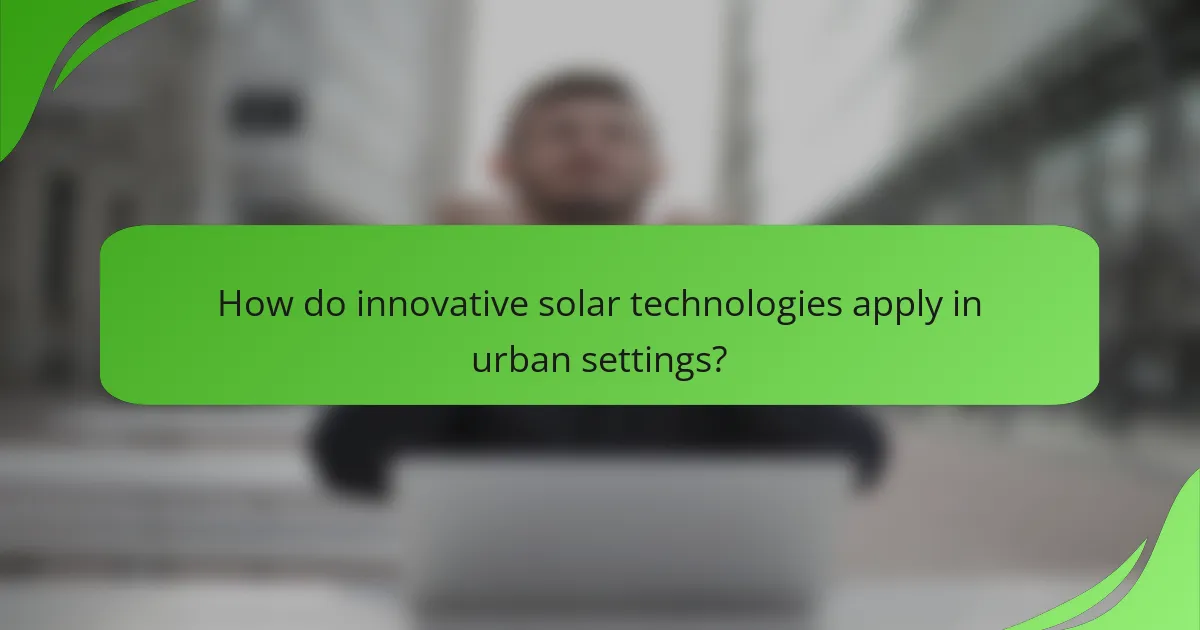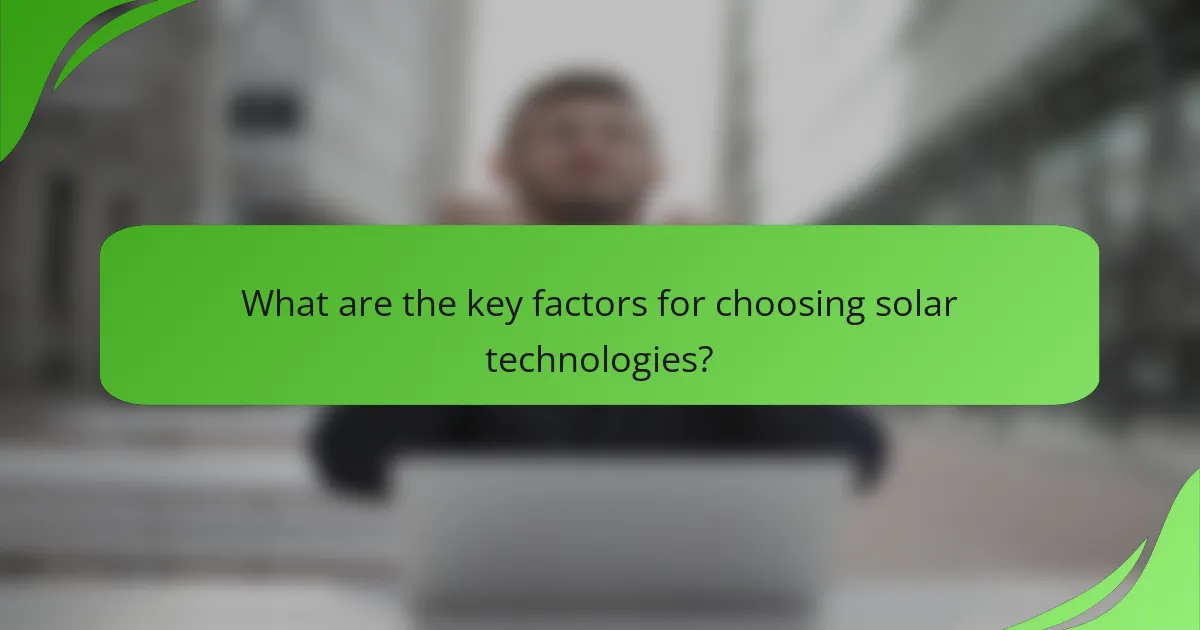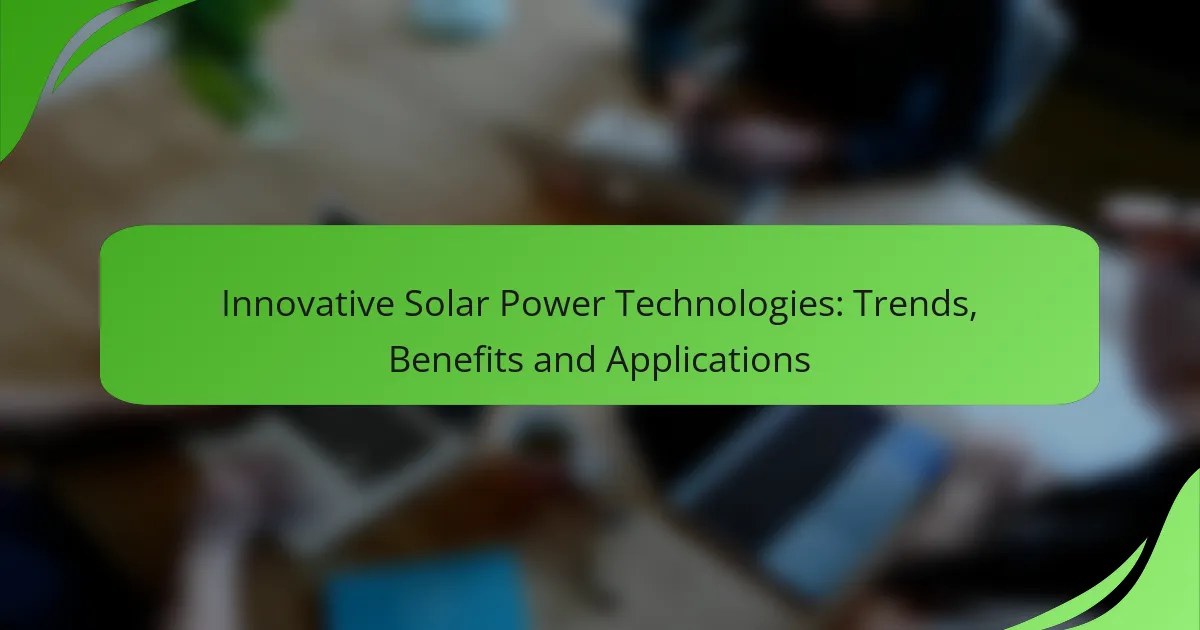Innovative solar power technologies are revolutionizing the energy landscape by improving efficiency, lowering costs, and broadening their applications across various sectors. These advancements not only enhance energy sustainability but also offer significant long-term savings and reduced environmental impact, making solar energy more accessible and effective for urban environments and beyond.

What are the latest innovative solar power technologies?
The latest innovative solar power technologies include advancements that enhance efficiency, reduce costs, and expand applications. These technologies are transforming how solar energy is harnessed and utilized across various sectors.
Perovskite solar cells
Perovskite solar cells are a new type of photovoltaic technology that utilizes a unique crystal structure to improve light absorption and energy conversion efficiency. They can be manufactured using low-cost materials and processes, making them a promising alternative to traditional silicon-based cells.
These cells can achieve efficiencies exceeding 25%, significantly higher than many conventional options. However, stability and long-term durability remain challenges that researchers are actively addressing.
Bifacial solar panels
Bifacial solar panels capture sunlight from both sides, allowing them to generate more energy than traditional single-sided panels. This technology is particularly effective in areas with reflective surfaces, such as snow or sand, which can enhance energy production by up to 30%.
When considering bifacial panels, it’s crucial to assess the installation environment and orientation to maximize their potential benefits. They may have a higher upfront cost, but the increased energy yield can lead to better long-term returns.
Solar skins
Solar skins are a visually appealing solution that integrates solar technology into building materials, such as roofing and facades. This innovation allows for seamless energy generation without compromising aesthetics, making solar power more accessible for residential and commercial buildings.
When choosing solar skins, consider the design compatibility with existing architecture and the potential for energy savings. They can be more expensive than traditional solar panels, but their aesthetic appeal may justify the investment for many homeowners.
Concentrated solar power
Concentrated solar power (CSP) systems use mirrors or lenses to focus sunlight onto a small area, generating heat that is then converted into electricity. CSP is particularly effective in sunny regions and can provide large-scale energy solutions for utilities.
These systems often include thermal storage, allowing energy to be generated even when the sun isn’t shining. However, CSP requires significant land and investment, making it more suitable for large-scale projects rather than small installations.
Floating solar farms
Floating solar farms are solar panel installations placed on bodies of water, such as lakes or reservoirs. This innovative approach reduces land use while providing cooling benefits that can enhance panel efficiency by up to 10%.
When considering floating solar, evaluate the environmental impact and regulatory requirements for water bodies in your area. These systems can also help reduce evaporation and improve water quality, adding to their appeal in certain contexts.

What are the benefits of innovative solar power technologies?
Innovative solar power technologies offer numerous benefits, including enhanced energy efficiency, lower installation costs, and improved environmental sustainability. These advancements enable users to harness solar energy more effectively, leading to significant long-term savings and reduced ecological impact.
Increased energy efficiency
Innovative solar technologies, such as bifacial solar panels and solar tracking systems, significantly boost energy efficiency. Bifacial panels capture sunlight from both sides, while tracking systems adjust the panel angle to follow the sun, maximizing exposure throughout the day.
These improvements can lead to energy output increases of 10-30% compared to traditional fixed panels. Homeowners and businesses can benefit from these technologies by generating more electricity from the same amount of solar surface area.
Reduced installation costs
Advancements in solar technology have led to reduced installation costs through streamlined manufacturing processes and improved materials. For instance, the use of lightweight materials and integrated systems can lower labor and transportation expenses.
Additionally, government incentives and rebates can further decrease upfront costs. In many regions, these financial aids can cover a substantial portion of installation expenses, making solar energy more accessible to a wider audience.
Environmental sustainability
Innovative solar power technologies contribute to environmental sustainability by reducing reliance on fossil fuels and lowering greenhouse gas emissions. By generating clean energy, solar systems help mitigate climate change and promote a healthier planet.
Moreover, many new solar products are designed with recyclable materials, minimizing waste at the end of their lifecycle. This commitment to sustainability aligns with global efforts to transition to renewable energy sources.
Energy independence
Utilizing innovative solar technologies can enhance energy independence for individuals and communities. By generating their own electricity, users can reduce their dependence on grid power and volatile energy markets.
This independence can be particularly beneficial in remote areas where access to traditional energy sources is limited. Additionally, energy storage solutions, such as advanced batteries, allow users to store excess energy for use during peak demand or outages, further enhancing self-sufficiency.

How do innovative solar technologies apply in urban settings?
Innovative solar technologies are increasingly being integrated into urban environments to enhance energy efficiency and sustainability. These applications not only reduce reliance on traditional energy sources but also contribute to urban aesthetics and functionality.
Building-integrated photovoltaics
Building-integrated photovoltaics (BIPV) seamlessly incorporate solar panels into the building envelope, such as roofs and facades. This technology allows structures to generate their own electricity while maintaining architectural integrity. For example, glass solar panels can replace traditional windows, providing both energy generation and natural lighting.
When considering BIPV, it’s essential to evaluate local building codes and aesthetic guidelines, as these can influence design choices. Additionally, the initial investment may be higher than conventional systems, but long-term savings on energy bills can offset these costs.
Smart solar streetlights
Smart solar streetlights are equipped with solar panels and energy-efficient LED bulbs, offering a sustainable lighting solution for urban areas. These lights can be equipped with sensors to adjust brightness based on pedestrian activity, enhancing safety and energy conservation. They are particularly useful in areas lacking electrical infrastructure.
When implementing smart solar streetlights, consider the placement to maximize sunlight exposure and ensure adequate battery life for nighttime operation. Maintenance is generally low, but regular checks on the solar panels and batteries can help maintain optimal performance.
Solar canopies for parking lots
Solar canopies provide shade for vehicles while generating electricity through mounted solar panels. These structures are ideal for parking lots, offering dual benefits of protecting cars from weather elements and supplying renewable energy. They can also include electric vehicle charging stations, promoting green transportation options.
To maximize the effectiveness of solar canopies, assess the available space and sunlight exposure in the parking area. Local regulations regarding height and design should also be reviewed to ensure compliance. Investing in solar canopies can lead to significant energy savings and enhance the overall value of the property.

What are the key factors for choosing solar technologies?
When selecting solar technologies, key factors include cost-effectiveness, space availability, and local climate conditions. These elements significantly influence the efficiency, installation, and long-term viability of solar power systems.
Cost-effectiveness
Cost-effectiveness is crucial when choosing solar technologies, as it determines the return on investment. Consider both initial installation costs and ongoing maintenance expenses. Comparing different solar panel types, such as monocrystalline and polycrystalline, can reveal significant price differences, with monocrystalline panels typically being more efficient but also pricier.
Evaluate available incentives, such as tax credits or rebates, which can substantially reduce upfront costs. In the U.S., for example, the federal solar tax credit allows homeowners to deduct a percentage of the installation costs from their federal taxes.
Space availability
Space availability directly impacts the type and size of solar technology you can implement. Larger systems require more roof or ground space, so assess your property to determine how much area can be dedicated to solar panels. For residential properties, rooftops are often the primary installation sites, while commercial buildings may have more options.
Consider the orientation and angle of the available space, as these factors influence solar panel efficiency. Ideally, panels should face south in the Northern Hemisphere to maximize sunlight exposure throughout the day.
Local climate conditions
Local climate conditions play a vital role in the performance of solar technologies. Regions with high solar irradiance, such as the southwestern U.S., are ideal for solar installations, while areas with frequent cloud cover may see reduced efficiency. Understanding your local weather patterns can help you choose the right technology.
Additionally, consider temperature variations, as extreme heat can affect solar panel efficiency. Some technologies, like thin-film solar panels, perform better in high temperatures compared to traditional silicon panels. Assessing local climate data can guide your decision on the most suitable solar technology for your area.
